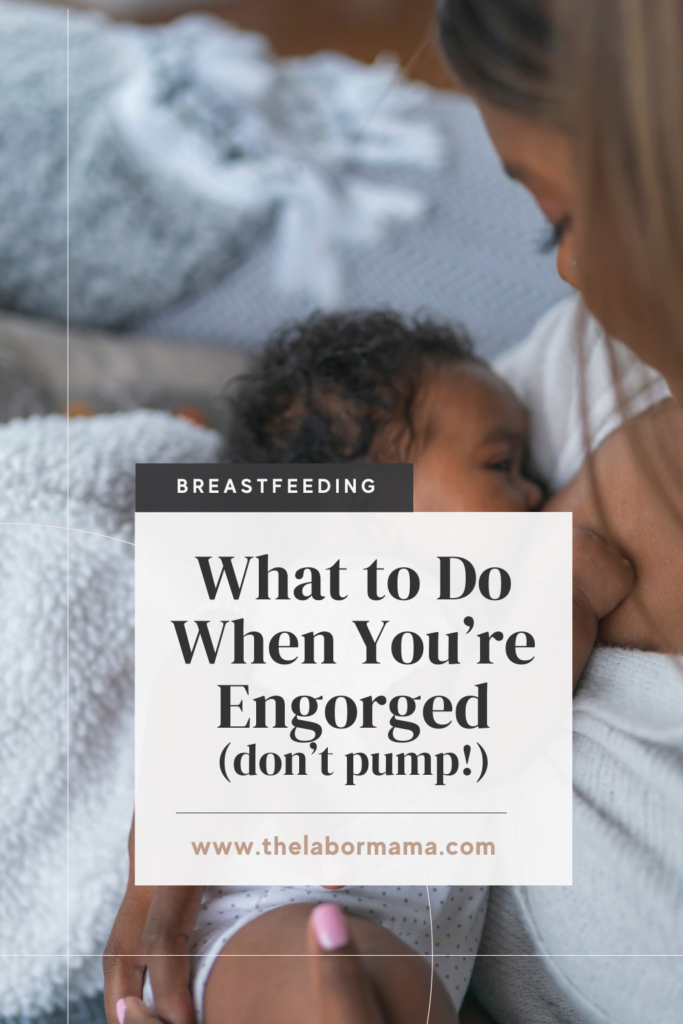Want to know what a REALLY common part of the first week of breastfeeding is? Postpartum engorgement. This situation will happen to almost everyone. And if you’re anything like I was my first baby, the details around it (and going through it) may take you by surprise. For some, it is also painful and intense, or you just don’t know what to do with it happens. So, I want to avoid that for you. If it’s normal (and yes, it is)- then I want you to know how to navigate it!

Who is The Labor Mama and Why Am I Here?
Hey friend! I’m Lo – also known around here and social media as The Labor Mama. I’ve spent my nursing career in labor, delivery, and postpartum, have birthed 4 of my own babies, have labored thousands of mamas at the bedside, have taught hundreds of students online, and have even delivered a few speedy little babies with my bare hands (oops).
Here at TLM, I offer online classes to empower you the way everyone should be. The education + support I offer gives you experience, evidence, and empathy; you’re getting all of my years of “clinical” RN knowledge, beautifully combined with my real experiences as a mama and a nurse. These are not your average hospital classes (those won’t do it, I promise), and honestly, birth, postpartum, and breastfeeding don’t follow a textbook or protocol anyway. You need to know so much more than that!
If you want to connect with me further, head to Instagram. There are hundreds of thousands of us over there learning together daily.
A note: This post may include affiliate links. This means if you make a purchase after clicking a link, I will earn a small commission (thank you)! Rest assured, this comes at no additional cost to you. You can read TLM’s full disclosure here.
What is Engorgement?
In general, the definition of engorgement is: the state of a part of the body that has become swollen or filled with fluid. Engorgement can happen in many different parts of the body, but right now, we’re talking about engorgement in the breasts. This happens when excessive pressure builds up in the breast, causing them to become swollen and distended.
Types of Engorgement
There are 2 types of engorgement, physiological and pathological. Physiological engorgement is the “normal” process that occurs with milk onset. When this occurs, you will note that the skin is tighter and that the breasts feel warm or hot. However, it should not be too uncomfortable and baby should still be able to latch onto the breast. With pathological engorgement, the swelling or enlargement of your breasts is much more pronounced. The skin may be really tight, and it could look shiny. The temperature of the breasts may feel really hot, and you will likely feel discomfort. When the breasts are this full and swollen, it can make it hard for baby to deeply latch onto the nipple and milk may not flow well.

When Does Engorgement Occur?
Normal, physiological engorgement symptoms most commonly occur around days 3-5 postpartum, when your milk production is still very much under control of the endocrine system (Stage 2 of Lactogenesis). However, if you had a lot of IV fluids in labor or delivered via cesarean, this process may be delayed about 24-48 hours or so. Depending on the volume of fluids received in labor or postpartum, it’s also possible that you’ll have higher general levels of swelling, including in the breasts, throughout the first week.
Hearing some terms that are unfamiliar? I get that! That’s what The Breastfeeding Blueprint is for. That course deep dives the breast milk process and stages (aka – lactogenesis) and all the things you need to know about body and baby as you live out your breastfeeding journey. Check it out and join me – you can start learning all the things right now!

What Causes Engorgement?
Like I mentioned prior, engorgement is a pressure issue. The buildup of pressure in the breasts is caused by a few different factors, including the accumulation of milk as the hormones of Stage 2 are doing their thing, the extra blood volume of pregnancy in the vascular spaces, and third spacing that can occur from extra fluids in the body (like those excess IV fluids). Basically, there is just a lot of extra fluid in the breasts and if the breasts aren’t being drained well, there is nowhere for the fluid to go!
When engorgement does start to progress towards more of the pathological symptoms, it is usually related to poor, inefficient drainage of the breast. This can happen if baby is not latching well or the latch is shallow, if they are nipple feeding, if they are not eating often enough, or if milk transfer is not happening or it is inadequate. It can also occur when an oversupply of milk is a concern.
Why Is Correcting Engorgement So Important?
While physiological engorgement is normal and it is NOT a reason to panic – and in fact, it should be an expectation, it is also important that you pay attention to it and ensure you are doing what you can to help it resolve. When breasts move towards more of those pathological symptoms and remain in that state for too long, it can actually significantly and negatively impact milk supply.
When I became a CLC, I remember being taught that unresolved engorgement is actually one of “nature’s early lactation dry-up mechanisms.” What they meant is that extensive, continued pressure inside the breasts will actually lead to a body that stops making milk.
This can occur because the milk secreting cells that surround the alveoli start to stretch and get inflamed and they can then block the capillary network (that means the blood flow) around the alveoli – this means hormones like prolactin and oxytocin can’t move about as they need to. Increased pressure around the alveoli can also change their shape and possibly cause permanent damage or alveolar death (which cannot be corrected until a subsequent pregnancy).

Lastly, when breasts are consistently too full, they start to fill up with something called the Feedback Inhibitor of Lactation (FIL). This is a protein in breastmilk that increases in concentration the more that the lumen (remember, that’s the open space in the middle of the alveolus) is filled with milk. When FIL levels are high, they can “down regulate” the prolactin receptors on the cells, essentially leading to less milk production.
So basically, that’s the big deal here! Engorgement can be uncomfortable, so that’s a great reason to want to correct it. And unresolved engorgement can lead to other issues like plugs or mastitis, which we’ll discuss later. But I’d say the biggest issue is this – that breasts that are too full for too long a period of time can eventually equal a decrease in or damage to your milk supply.
More here: Breastfeeding: A Healthy Milk Supply from Day One
Are There Risk Factors for Engorgement?
You now know that insufficient breast emptying is one of the biggest reasons that engorgement can progress too far. So when it comes to risk factors, we would want to be considering things that may cause that insufficient emptying. This includes:
- Nipple concerns that may inhibit deep latch (inverted nipples, flat nipples that do not evert)
- Long labor or induction (related to increased IV fluids)
- Cesarean birth (delays Stage 2 of lactogenesis)
- Feeding on a schedule as opposed to cue-based or baby-led
- Tongue or cheek ties that impact latch (oral restriction)
- Immature/weak suck reflex
- Separation from baby that results in less frequent emptying
- Jaundice/low blood sugar (sleepy, less efficient babies)
- History of breast augmentation (implants can increase pressure)
There will be many of us who may run into one of these risk factors and have amazing breastfeeding relationships, so I don’t want that list to worry you! Instead, I hope it helps you understand and appreciate the value of feeding or expressing frequently while we navigate whatever else may be going on with us and our babes.
How to correct engorgement
The obvious question at this point is: How do we manage physiological engorgement and try to prevent moving towards pathological engorgement or getting stuck there for too long? Mostly? This is all about removing milk regularly and effectively.
Should you pump to relieve engorgement?
But the first thing I want you to hear is that most often, pumping is NOT the answer. Essentially, pumping and emptying your breasts will actually tell your body to make MORE milk…and this will exacerbate the engorgement issue!
So, let’s get into the other things that you should consider when dealing with engorgement.
According to the Academy of Breastfeeding Medicine (ABM), more time spent breastfeeding in the 48 hours of life is associated with less engorgement. This means that in those early hours, you really do want to be latching and expressing milk frequently. And like we’ve already talked about, if baby is not latching well, or you are apart, you can absolutely be hand expressing every couple of hours in these first days.
You can also consider rooming in! If the phrase “rooming in” is new to you, it simply refers to keeping baby in your room for rest, as opposed to sending them to the nursery while in the hospital or having them in another room at night once you are home. Specific to feeding, the benefit here is that parents pick up on and learn feeding cues sooner when they are with their baby, so there is less likelihood of delaying any feeds and increased likelihood of baby being fed a bit more often in these early hours.
How to latch baby if you’re engorged
Okay, so if the issue of inefficient latch and milk transfer is related to nipples and tissue that are just too swollen, there are a couple of things to try before latching baby.
- Hand Expression: Doing a couple of minutes of hand expression before latching baby to breast can help soften the nipple and alveolar tissue and allow for baby to latch more deeply. It’s also what you can be doing if you and baby are separated.
- Reverse pressure softening: This is a process where you use your fingers around the nipple and areola to try and gently and temporarily move fluids away from the nippple area and up into the breasts. You can do this by pressing all 5 of your fingers around the base of the nipple for about a minute or you can press down around the nipple in that C shape we’ve talked about prior.
- Manual Hand Pump: If you have a manual hand pump, you can use this for a couple of minutes to remove a small volume of milk and soften the area before you latch baby on. I’d still suggest hand expression first, as it can be quicker and easier here! But if the volume of milk being expressed before you can latch on is pretty significant, then the hand pump may be the right choice.
- Electric Pump: If you don’t have a manual pump and hand expression isn’t going to cut it, you can utilize an electric pump for a couple of minutes. However, we don’t want to be encouraging MORE milk production, so I wouldn’t use these pumps for long, I’d have it on a lower suction setting, and I’d be really mindful about only using it to soften the area before latching baby.
Once you’ve got baby latched onto the breast and transferring milk, gentle manual massage or breast compression, when the baby is not sucking, can also be helpful in encouraging milk to flow.
How to relieve an engorged breast
Lastly, let’s chat about how to manage any pain and discomfort related to the swollen tissues. There are 3 things you may want to consider trying for symptom management:
- Lymphatic drainage
- Ice and heat
- NSAIDS/anti inflammatory meds
Lymphatic drainage is a gentle massage technique that tries to reduce swelling by moving fluids away from the nipple and up (as opposed to the idea of massaging down and out). Many refer to it as “petting a cat,” so the traction on the skin is relatively gentle and light. Typically, lymphatic drainage is done via small circles up around your clavicle, near the armpit, and then sweeping motions from nipple up towards clavicle or armpit.
Using ice and heat is another way to manage discomfort. Recent protocols from the ABM support using ice more than heat, though the consensus seems to be that both can be used in appropriate ways and per your preference.
Typically, the thought is that engorgement is an inflammatory process, so using heat too liberally will actually encourage MORE fluids to flow to the area, while the use of ice will vasoconstrict and discourage the movement of more fluids to the area. However, I’ve often seen a combination of warmth or heat before latching to encourage the breasts to soften and the milk to flow and then ice on the breasts after and between feeds. I personally feel this can be a great way to manage discomfort.
Lastly, medications that are a mild analgesic (like acetaminophen) and/or have anti inflammatory properties (like an ibuprofen) can also be helpful in managing symptoms. These are both standardly prescribed for postpartum and can be taken when breastfeeding.
The takeaway on postpartum engorgement after birth
“Regular,” physiological engorgement IS normal, but that doesn’t always make it easy. But, because you now know that it’s a normal part of your milk supply coming in and the start of your breastfeeding story, I hope it doesn’t shock you or make you feel like you have no idea what’s going on! There are little ways to work through it and make it “better” that begin right at birth, and there are definitely things to do at home to help you get through any discomfort and prevent anything from progressing to other inflammatory issues like clogged ducts and mastitis.
Did you experience engorgement? Did it hurt? How’d you deal? Let me know in the comments, please! xx- Lo

More resources (and freebies!) for you to take a peek at:




